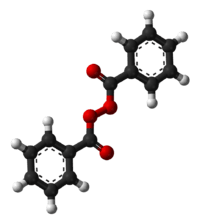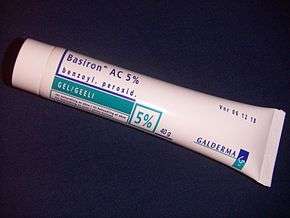Benzoyl peroxide
 | |
 | |
| Names | |
|---|---|
| IUPAC name
dibenzoyl peroxide | |
| Other names
Benzoyl peroxide (BPO) Benzoperoxide | |
| Identifiers | |
| 94-36-0 | |
| 3D model (Jmol) | Interactive image |
| ChEMBL | ChEMBL1200370 |
| ChemSpider | 6919 |
| ECHA InfoCard | 100.002.116 |
| EC Number | 202-327-6 |
| E number | E928 (glazing agents, ...) |
| KEGG | D03093 |
| PubChem | 7187 |
| RTECS number | DM8575000 |
| UNII | W9WZN9A0GM |
| |
| |
| Properties | |
| C14H10O4 | |
| Molar mass | 242.23 g·mol−1 |
| Appearance | colourless solid |
| Density | 1.334 g/cm3 |
| Melting point | 103 to 105 °C (217 to 221 °F; 376 to 378 K) decomposes |
| poor | |
| Pharmacology | |
| D10AE01 (WHO) QD11AX90 (WHO) | |
| Hazards | |
| Main hazards | irritant, explosive[1] |
| Safety data sheet | See: data page |
| EU classification (DSD) |
|
| R-phrases | R3, R7, R36, R43 |
| S-phrases | (S2), S3/7, S14, S36/37/39 |
| NFPA 704 | |
| Flash point | 80 °C; 176 °F; 353 K[1] |
| 80 °C (176 °F; 353 K) | |
| Lethal dose or concentration (LD, LC): | |
| LD50 (median dose) |
7710 mg/kg (mouse, oral)[2] |
| LC50 (median concentration) |
7000 mg/m3 (mouse, 4 hr)[2] |
| US health exposure limits (NIOSH): | |
| PEL (Permissible) |
TWA 5 mg/m3[1] |
| REL (Recommended) |
TWA 5 mg/m3[1] |
| IDLH (Immediate danger) |
1500 mg/m3[1] |
| Supplementary data page | |
| Refractive index (n), Dielectric constant (εr), etc. | |
| Thermodynamic data |
Phase behaviour solid–liquid–gas |
| UV, IR, NMR, MS | |
| Except where otherwise noted, data are given for materials in their standard state (at 25 °C [77 °F], 100 kPa). | |
| | |
| Infobox references | |
Benzoyl peroxide (BPO) is an organic compound in the peroxide family. It consists of two benzoyl groups bridged by a peroxide link. Its structural formula is (C6H5CO)2O2. It is one of the most important organic peroxides in terms of applications and the scale of its production. Benzoyl peroxide is used as an acne treatment, for bleaching flour, hair and teeth, for cross-linking polyester resins, and for many other purposes.
It is on the World Health Organization's List of Essential Medicines, the most important medications needed in a basic health system.[3]
Uses
Most benzoyl peroxide is used as a radical initiator to induce polymerizations.[4] Other major applications include its antiseptic and bleaching properties.
Acne treatment

Benzoyl peroxide (BPO) is effective for reducing the number and severity of acne lesions. BPO has a bactericidal effect on Propionibacterium acnes bacteria associated with acne and does not induce antibiotic resistance.[5][6] It may be combined with salicylic acid, sulfur, erythromycin or clindamycin (antibiotics), or adapalene (a synthetic retinoid). Two common combination drugs include benzoyl peroxide/clindamycin and adapalene/benzoyl peroxide, an unusual formulation considering most retinoids are deactivated by peroxides. Combination products such as benzoyl peroxide/clindamycin and benzoyl peroxide/salicylic acid appear to be slightly more effective than benzoyl peroxide alone for the treatment of acne lesions.[6]
Benzoyl peroxide for acne treatment is typically applied to the affected areas in gel or cream form, in concentrations of 2.5% increasing through 5.0%, and up to 10%.[5] No strong evidence supports the idea that higher concentrations of benzoyl peroxide are more effective than lower concentrations.[5]
Benzoyl peroxide commonly causes initial dryness and sometimes irritation, although the skin develops tolerance after a week or so. A small percentage of people are much more sensitive to it and liable to suffer burning, itching, crusting, and possibly swelling.[7] It is sensible to apply the lowest concentration and build up as appropriate. Once tolerance is achieved, increasing the quantity or concentration and gaining tolerance at a higher level may give better subsequent acne clearance.[8] Irritation can also be reduced by avoiding harsh facial cleansers and wearing sunscreen prior to sun exposure.[8]
Other uses
Other common uses for benzoyl peroxide include
- Bleaching hair
- Tooth whitening systems
- The preparation of bleached flour
- As a convient oxidant in organic chemistry
- An initiator and catalyst for polyester thermoset resins, as an alternative to the much more hazardous methyl ethyl ketone peroxide.
- A hardener in order to start the polymerization process in resins. For instance, PMMA resins can be polymerized with benzoyl peroxide.[9]
- Removing ink and dye stains on vinyl dolls and other playscale figures.[10]
In the U.S., the typical concentration for benzoyl peroxide is 2.5% to 10% for both prescription and over-the-counter drug preparations that are used in treatment for acne. Higher concentrations are used for hair bleach and teeth whitening. Benzoyl peroxide, like most peroxides, is a powerful bleaching agent. Contact with fabrics or hair can cause permanent color dampening almost immediately. Even secondary contact can cause bleaching; for example, contact with a towel that has been used to wash off benzoyl peroxide-containing hygiene products.[11]
Side effects
Concentrated benzoyl peroxide is potentially explosive[12] like other organic peroxides, and can cause fires without external ignition. The hazard is acute for the pure material, so the compound is generally used as a solution or a paste. For example, cosmetics contain only a small percent of benzoyl peroxide and pose no explosion risk.
The carcinogenic potential of benzoyl peroxide has been investigated. A 1981 study published in the journal Science found that although benzoyl peroxide is not a carcinogen, it does promote cell growth when applied to an initiated tumor. The study concluded, "caution should be recommended in the use of this and other free radical-generating compounds".[13]
In a 1977 study using a human maximization test, 76% of subjects acquired a contact sensitization to benzoyl peroxide. Formulations of 5% and 10% were used.[14]
The U.S. National Institute for Occupational Safety and Health has developed criteria for a recommended standard for occupational exposure to benzoyl peroxide.[15]
- Skin irritation due to benzoyl peroxide
 A bleached fabric stain caused by contact with benzoyl peroxide.
A bleached fabric stain caused by contact with benzoyl peroxide.
Synthesis, structure and physical properties
Benzoyl peroxide was the first organic peroxide prepared by intentional synthesis. It was prepared by treating benzoyl chloride with barium peroxide,[16] a reaction that probably follows this equation:
- 2 C6H5C(O)Cl + BaO2 → (C6H5CO)2O2 + BaCl2
Benzoyl peroxide is usually prepared by treating hydrogen peroxide with benzoyl chloride.
- 2 C6H5COCl + H2O2 + 2 NaOH → (C6H5CO)2O2 + 2 NaCl + 2 H2O
The oxygen–oxygen bond in peroxides is weak. Thus benzoyl peroxide readily undergoes homolysis (symmetrical fission), forming free radicals:
- (C6H5CO)2O2 → 2 C
6H
5CO•
2
The symbol • indicates that the products are radicals; i.e., they contain at least one unpaired electron. Such species are highly reactive. The homolysis is usually induced by heating. The half-life of benzoyl peroxide is one hour at 92 °C. At 131 °C, the half-life is one minute.[17]
Benzoyl peroxide breaks down in contact with skin, producing benzoic acid and oxygen, neither of which is significantly toxic.[18]
References
- 1 2 3 4 5 "NIOSH Pocket Guide to Chemical Hazards #0052". National Institute for Occupational Safety and Health (NIOSH).
- 1 2 "Benzoyl peroxide". Immediately Dangerous to Life and Health. National Institute for Occupational Safety and Health (NIOSH).
- ↑ "WHO Model List of EssentialMedicines" (PDF). World Health Organization. October 2013. Retrieved 22 April 2014.
- ↑ Klenk, Herbert; Götz, Peter H.; Siegmeier, Rainer; Mayr, Wilfried (2005), "Peroxy Compounds, Organic", Ullmann's Encyclopedia of Industrial Chemistry, Weinheim: Wiley-VCH, doi:10.1002/14356007.a19_199
- 1 2 3 Simonart, T. (December 2012). "Newer approaches to the treatment of acne vulgaris". Am. J. Clin. Dermatol. 13 (6): 357–64. doi:10.2165/11632500-000000000-00000. PMID 22920095.
- 1 2 Seidler, E. M.; Kimball, A. B. (July 2010). "Meta-analysis comparing efficacy of benzoyl peroxide, clindamycin, benzoyl peroxide with salicylic acid, and combination benzoyl peroxide/clindamycin in acne". J. Am. Acad. Dermatol. 63 (1): 52–62. doi:10.1016/j.jaad.2009.07.052. PMID 20488582.
- ↑ "Benzoyl peroxide". Mayo Clinic. January 1, 2016.
- 1 2 Alldredge, Brian K., ed. (2013). Applied Therapeutics: The Clinical Use of Drugs (10th ed.). Baltimore: Wolters Kluwer Health/Lippincott Williams & Wilkins. p. 949. ISBN 978-1609137137.
- ↑ http://www.degaroute.com/sites/dc/Downloadcenter/Evonik/Product/DEGAROUTE/en/Degaroute%20Brosch%C3%BCre.pdf
- ↑ Stevens, Cynthia. "Oxy10 for vinyl stains. Benzoyl Peroxide removes stain from Vinyl. Restore Dolls". Prilly Charmin Dolls. Retrieved 9 February 2015.
- ↑ Bojar, R. A.; Cunliffe, William; Holland, K. T. (1995), "The short-term treatment of acne vulgaris with benzoyl peroxide: effects on the surface and follicular cutaneous microflora.", Br. J. Dermatol., 132: 204–8, doi:10.1111/j.1365-2133.1995.tb05014.x, PMID 7888356
- ↑ Cartwright, Hugh (17 March 2005). "Chemical Safety Data: Benzoyl peroxide". Oxford University. Retrieved 13 August 2011.
- ↑ "Skin tumor-promoting activity of benzoyl peroxide, a... [Science. 1981] - PubMed - NCBI". Ncbi.nlm.nih.gov. 2012-05-24. Retrieved 2012-09-08.
- ↑ Leyden, James J.; Kligman, Albert M. (1977), "Contact sensitization to benzoyl peroxide", Contact Dermatitis, 3 (5): 273–75, doi:10.1111/j.1600-0536.1977.tb03674.x
- ↑ "Criteria for a Recommended Standard: Occupational Exposure to Benzoyl Peroxide (77-166)". CDC - NIOSH Publications and Products. June 6, 2014. Retrieved 2016-07-15.
- ↑ Brodie, B. C. (1858), "Ueber die Bildung der Hyperoxyde organischer Säureradicale" [On the Formation of the Peroxides of Organic Acid Radicals], Justus Liebigs Ann. Chem., 108: 79–83, doi:10.1002/jlac.18581080117
- ↑ Li, Hui, III (1998). "Chapter 2". Synthesis, Characterization and Properties of Vinyl Ester Matrix Resins (PDF) (Ph.D.). University of Vermont.
- ↑ Benzoyl peroxide (PDF), SIDS Initial Assessment Report, Geneva: United Nations Environment Programme, April 2004
External links
- International Chemical Safety Card 0225
- "NIOSH Pocket Guide to Chemical Hazards #0052". National Institute for Occupational Safety and Health (NIOSH).
- SIDS Initial Assessment Report from the Organisation for Economic Co-operation and Development (OECD)
- "Benzoyl peroxide", Re-evaluation of Some Organic Chemicals, Hydrazine and Hydrogen Peroxide (PDF), IARC Monographs on the Evaluation of Carcinogenic Risks to Humans 71, Lyon: International Agency for Research on Cancer, 1999, pp. 345–58, ISBN 92-832-1271-1.
